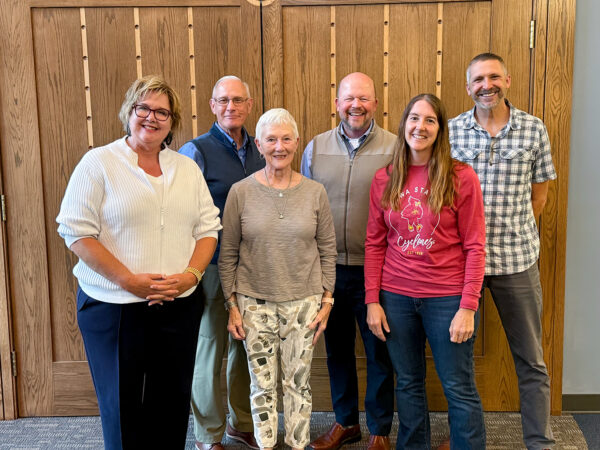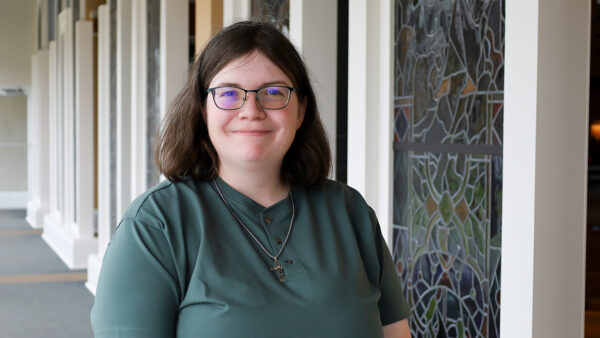Delight in the Beauty of the Butterfly
It’s a nearly 3,000 mile journey. The voyage of a butterfly is a long, remarkable trek. The first generation of butterflies mate in Texas and go through a month-long maturation process. Only the second-generation females make their way north to lay their eggs, typically arriving in Eastern Iowa mid to late May.
The life cycle of a butterfly is fascinating. A female butterfly will lay 100 to 300 eggs on the underneath side of a milkweed leaf. Once these eggs hatch, the larvae go through a maturation process, enter a chrysalis, and an adult butterfly emerges. In the Midwest they’ll stay up to three weeks and then make their way farther north, continuing that process until the last generation migrates down to Mexico for the winter and the whole cycle starts all over again.
St. Paul members Becky Griesbach and Heather Hepner have spent countless hours experiencing the beauty of the butterfly life cycle. Both started their butterfly hobbies in the same fashion, a project each of their daughters brought home and a continuing fascination with the butterfly life cycle.
Becky
Regrowing the butterfly population
“I raise monarch butterflies,” said Becky. “It got started with a project of one of my daughters at school in North Scott. They did a butterfly unit first part of the school year back in the late 90s and it just got me interested.”
She started raising butterflies in her home when she realized the rapid decline in the butterfly population. In 1997, researchers estimated there were 1.2 million but by 2019, only 29,000 butterflies remained.
“I started wholeheartedly in 2015, after a lot of discussion with friends and when I found out just how much they had declined,” she recalls. “Mexico is where they’ll actually do the count when the monarchs are wintering. They roost and they have tree, after tree, after tree of them so they measure how many hectares. Hectares are two and a half acres each. In the winter of 1996 into 1997, there were 18.2 hectares. Last year we were down to 2.8 hectares. That’s how much they’ve declined.”
Habitat destruction is the biggest reason for the rapid decline. It’s caused by humans with the creation of roads, housing developments, and agriculture. These developments transform the landscape, losing the natural habitat and milkweed needed for butterflies to survive.
You don’t need a fancy setup. It only requires minimal supplies. Becky uses tupperware to store the eggs which turn into caterpillars and finally, butterflies.
“It’s so much fun to raise them. You just need a good milkweed supply. You purchase a swamp milkweed plant and put it in your garden.”
Milkweed is essential for the butterflies to survive. It’s what they eat and lay their eggs on. The reason they use it to lay their eggs is because it secretes a chemical that is a natural repellent to protect the eggs from other insects and birds who don’t like the chemical taste. But milkweed is becoming more scarce with the destruction of the natural prairie.
“Anything we humans can do to help keep the natural prairie, that’s going to help the process,” she said. “Even just creating a simple nectar garden or monarch waystation.”
Only about 2% of butterflies in the wild will survive from egg to adult. When raised inside, the survival rate increases to 90%.
Becky’s passion goes beyond just raising butterflies. Armed with an iMovie containing facts, data, photos, and backed by a song about butterflies, Becky educates others to bring awareness to the decline in monarch butterflies and the need for repopulation of the butterfly community.
“Just knowing that I can help repair a small part of what we’ve done to nature is the best part of raising butterflies,” Becky said. “It’s very heartening. It’s changed the way I live in a lot of respects. In respect to the earth, other animals, other people, relationships, kindness. It’s that giant circle of life. You learn to be more compassionate. It’s the learning to be more mindful. A lot more understanding of life and everything around me.”
Heather
Bonding over butterflies
Fourteen years ago, what started as a small project, has blossomed into a hobby for the entire family.
“My daughter, Maizie, went to a workshop when she was five years old and came home with a monarch and I started learning about it with her,” Heather Hepner said.
Looking for the eggs and caterpillars quickly grew to include Heather’s younger daughter, Charlie.
“When the kids were little and we were in the car they would see milkweed and they’d say, “milkweed!” so we’d safely pull over on the side of the road and jump out and go down in the ditch and look for caterpillars and we’ve brought them home many, many times that way,” Heather said.
She homeschooled her two girls, until Maizie left for college, and raising the butterflies lent itself perfectly to the curriculum.
“This just went right along with what we were doing,” she said. “We’d sit and watch them in the kitchen. We’d spend hours watching the caterpillars eat. If the house is quiet and they’re eating, you can actually hear them crunching. I can’t tell you — it’s been countless hours of watching them.”
All that time watching, the Hepners soon discovered the caterpillars have their own personalities.
“They have their little idiosyncrasies,” Heather said. “Sometimes they don’t want to be touched and they’ll bop their heads. The swallowtails are really funny because they have horns that stick out, you don’t see them, there’s nothing there, and then they get mad and this long thing comes out and it’s orange with these two things on the end.”
One of the most unexpected things for Heather about raising caterpillars is how it becomes the interest of everybody that comes to her house.
“Anybody that visits sees the aquarium and is like “oh, what’s in there?!” she said. “Everyone thinks it’s pretty cool. I know, over the years, both of my parents have been there and have gotten to release the butterflies. Everyone’s gotten to hold the butterfly, walk outside, and watch it take off.”
Even though Maizie is now 19 and Charlie is 14, they haven’t lost their love of finding eggs and caterpillars.
“The girls will still come into the house and say, “Oh look I found three!” And I’ll be like, “Great! Here we go again,” she laughed. “But none of us can help it. If you find one, you can’t help but bring it in because you know what can happen to it. If you look and you find one, you know it’s coming in. Last summer, they were still bringing caterpillars in.”
For many years, it’s been a part of their entire summer, always an aquarium sitting in their kitchen, always, every summer and into the fall.
“I’m glad that we accidentally stumbled into raising monarchs because we’ve helped the monarch population and it’s been something we did as a family,” Heather said. “My girls, husband, and I look at them sometimes like it’s our little project together. When we drive around and stop and look for caterpillars, the kids are in heaven.”




